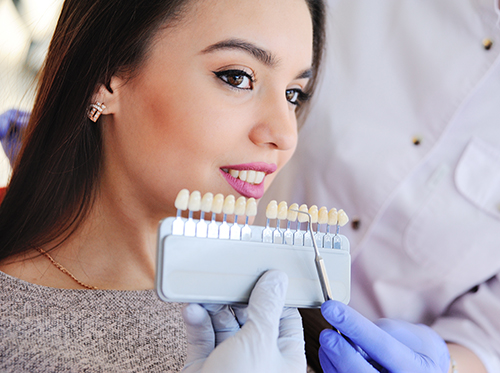December 4th, 2024

Like many other parts of the human body, teeth age. You may look at old photos and realize your smile was significantly brighter in the past than it is now. Many adults experience tooth discoloration and find it embarrassing.
The good news is there are treatment options! The first step to recovering your bright smile and finding appropriate treatment is to determine what’s causing the discoloration.
There are multiple reasons for tooth discoloration. Some are under your control, but unfortunately, others may not be. Glance at the list below and see if you can pinpoint the cause of your tooth discoloration.
- Poor Dental Hygiene: This one is obvious. There’s a reason your parents (and dentist) always told you to brush and floss three times a day.
- Genetics: A big part of your dental health is determined by genetics; in other words, what runs in your family. Sometimes people inherit naturally discolored teeth.
- Diet: Do you eat sugary foods often? Drink lots of soda? Gulp more than two cups of coffee a day? Are you an energy drink fan? We’re not pointing any fingers ... but you should do the math.
- Tobacco: Because cigarettes contain nicotine, they can readily stain your teeth. So hardcore smokers often develop prominent brown stains.
- Medications: Medicines such as doxycycline, tetracycline, antihistamines, blood-pressure medications, and antipsychotic drugs can all create tooth discoloration as a side effect. (If you suspect this could be the case for you, don’t ever discontinue your medication without consulting your doctor first!)
Did you find the culprit? Perhaps the easiest way to avoid tooth discoloration in your case might be to make some simple adjustments to your diet and other habits.
Also, when you consume drinks or foods that are high in acid or sugar content, take a moment to rinse your mouth with water afterward. If you’re an avid tobacco user, you may want to reconsider that; especially because it can have deadly effects that go way beyond your smile.
Dr. Cynthia Stephenson can also suggest other treatment options. While over-the-counter agents do help, in-office whitening treatments tend to be more effective. If whitening agents don’t alleviate the problem, you may want to consider bondings or veneers.
If you’re worried about discoloration of your teeth, or have any questions about how to treat it, please feel free to reach out to our Walnut Creek, California office! We can help you identify what may be causing the problem and work with you to give you a smile you’ll be proud of.
November 27th, 2024

The short answer to this question? Yes. Because your child’s breath is a reflection of his or her oral health, you should talk to Dr. Cynthia Stephenson if you notice any unpleasant changes. While better dental hygiene is usually the answer for young children, bad breath can also be a symptom of more serious problems.
Oral Hygiene
Most often, bad breath is simply a sign that your child needs a little help developing proper brushing and flossing habits.
- Show your child how to use a soft-bristled brush that fits in the mouth comfortably, be sure to brush all the surfaces of each tooth, and don’t forget to angle toward the gum line. And brush long enough. Once all the baby teeth have arrived, two minutes of brushing is usually recommended for children.
- It’s not too early to floss! Adults need to handle the flossing duties for children until they can manage on their own, so it’s a perfect time to teach technique. And, just like toothbrushes, floss should be flexible and soft.
- Don’t forget the tongue. Our tongues harbor the bacteria that cause bad breath, so finish off your child’s routine with a gentle brush of the tongue.
Better oral habits mean not only fresh breath, but give those baby teeth the best chance of staying healthy until they are naturally replaced by adult teeth. After all, baby teeth not only help your child learn to eat and speak properly, but they act as necessary placeholders so the permanent teeth are able to erupt in exactly the right spot.
Talk to a member of our Walnut Creek, California office team at your child’s next appointment if you are concerned about oral hygiene–they have many great suggestions for making brushing and flossing more efficient, comfortable, and even fun for your child.
November 27th, 2024

“Shouldn’t that be healthy gums,” you’re thinking? And, of course, you’re correct. Healthy gums are extremely important not only for our dental well-being, but for our overall physical health.
But that’s a subject for another blog! Today, we’re talking about healthy gum—chewing gum, that is. Because choosing the right chewing gum can actually improve your dental health.
Oral bacteria use the foods we eat, especially sugars and simple carbs, as fuel to produce acid. These acids attack our tooth enamel, gradually weakening the minerals in the tooth surface and allowing cavities to develop. Clearly, we want to reduce these acids to help prevent decay. Luckily, our bodies have a natural defense against acid attacks—saliva.
Saliva works to protect our enamel in three ways:
- It helps neutralize and wash away acids in the mouth.
- It rinses away the food particles which bacteria feed on.
- It strengthens teeth by providing the necessary minerals our enamel needs to “remineralize” after acids have weakened the tooth surface.
Studies have concluded that chewing sugarless gum for 20 minute after a meal can help prevent cavities. Why? Because chewing gum increases saliva production. You are actually reducing the effects of harmful acids, washing food particles away from your teeth, and strengthening weakened enamel with every stick! Some artificial sweeteners are even thought to inhibit the growth of the bacteria that lead to decay.
With all that in mind, it’s also healthy to know when you shouldn’t chew gum:
- When the gum contains sugar. Even with an increase in saliva production, bathing your teeth in sugar as you chew does your enamel no favors!
- When you wear braces. Gum can stick to your brackets and between your brackets and your wires. And while trying to clean gum from your appliance is no one’s idea of fun, an even more unpleasant possibility is the chance that gum might bend your wires out of shape. Sugarless gum is not quite as sticky as regular gum, but before you open that first pack, check with your orthodontist to see if you might be putting your orthodontic work at risk.
- When you have jaw problems such as TMD, TMJ or other temporomandibular concerns, or if you develop jaw pain while chewing gum.
- You should never give gum to a child too young to understand that it should not be swallowed. Beyond acting as a choking hazard, continual gum swallowing can lead to diarrhea, blockages, abdominal pain and other serious problems. Talk to your Dr. Cynthia Stephenson about the right age for chewing gum.
While chewing sugarless gum has the potential to improve dental health, remember it should never take the place of regular brushing and flossing—still the best way to prevent cavities at home. Talk to Dr. Cynthia Stephenson about the possible benefits of sugarless gum at your next visit to our Walnut Creek, California office, and we can make recommendations based on your individual dental history. Because whether it’s healthy gums or healthy gum, we’re here to help.
November 20th, 2024

Your gums are responsible for a large part of your overall oral health. So keeping them healthy and knowing how to detect gum disease is extremely important.
Since it’s often painless, gum disease may go unnoticed and can progress when left untreated. Understanding the causes of gum disease will give you the ability to keep your oral health in great shape:
- Bacteria and Plaque. Good hygiene helps remove bacteria and plaque from teeth. When plaque is not removed, it turns into a rock-like substance called tartar, which can only be removed by a dentist.
- Smoking and Tobacco. Smokers and tobacco users put themselves at a higher risk of developing gum disease. Tobacco use can also stain your teeth, give you bad breath, and increase the risk of oral cancer. It’s best to avoid using tobacco altogether.
- Certain Medications. Ironically, certain medications for other health conditions can increase your risk of developing gum disease. Talk with Dr. Cynthia Stephenson if you have concerns about a medication you are taking. Steroids, anti-epilepsy drugs, certain cancer therapy medications, and oral contraceptives can be among the culprits.
- Medical Conditions. Certain medical conditions can also affect your gum health. Diabetics can have an increased risk of gum disease due to the inflammatory chemicals in their bodies. Talk to our team about your health condition so we can take that into account when treating you.
Luckily, there are actions you can take to prevent gum disease. You should make regular visits to our Walnut Creek, California office for regular cleanings. It’s also worthwhile to maintain good hygiene habits at home, such as flossing and brushing at least two times every day.
Good oral hygiene practice and visits to our Walnut Creek, California office can help you eliminate or reduce the risks of developing gum disease!






